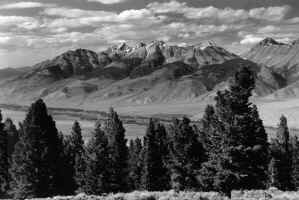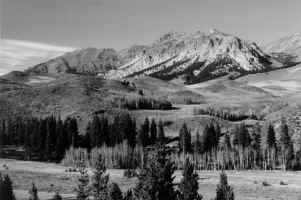|
Page
19
|


|
||
 |
||
| The west face of the Lost River Range, above the Big Lost River Valley. View looks northeast from the Burma Road, northwest of Mackay. The range is made up of folded Proterozoic and Paleozoic sedimentary rocks. The Lost River normal fault runs along the base of the mountains, and has been active over the last few million years. Huge alluvial fans radiate from the steep canyons and spread out over the valley. Borah Peak is the jagged high point on the north (left) end of the view. It is underlain by the Silurian Laketown Dolomite and Devonian Jefferson Formation. Leatherman Peak is on the extreme right, south of a normal fault that drops upper Paleozoic rocks down to the south, (July, 1993). | ||
 |
||
| The west face of the Boulder Mountains north of Ketchum, view to the northeast. A normal fault that runs through the low hills in the foreground has uplifted the mountains above the Wood River Valley. The white rocks in the cliffs at the base of the range are Eocene granite. The dark rocks on the summits are Devonian Milligen Formation and Pennsylvanian and Permian Wood River Formation, (October, 1991). |
The cumulative offset on these normal faults is much greater than the observed topographic relief because the upraised mountains are continually being eroded and the downdropped valleys filled with the debris carried down from the mountains. For example, just north of Downey, the floor of Marsh Valley is about 5,000 feet elevation and the summit of Oxford Peak to the south is just over 9,000 ft. But gravity studies demonstrate that beneath Downey are about 10,000 feet of valley fill, so that the "real" or structural floor of the valley is at 5,000 feet below sea level. The net displacement on the normal faults in southern Marsh Valley is thus at least 15,000 feet, not accounting for any erosion off the top of Oxford Mountain.
A normal fault which produces a major earthquake like that at Borah Peak with offset of 6 feet every 2,000 years (a net movement rate of 0.04 inches per year), will produce 15,000 feet of offset in 5 million years. Such rates appear reasonable based on geologic and paleoseismic data.
The total amount of lateral extension undergone by southeast Idaho over the last 16 million years is as much as 40 miles, at rates of 3.7 to 5.0 inches/year. Thus it is about 20 miles farther from Pocatello to Montpelier than it was 16 million years ago.